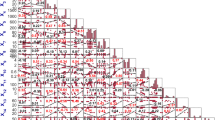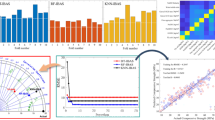Abstract
This research presents a comprehensive study on predicting the compressive strength (CS) of PET-fiber-reinforced concrete (PFRC) using three decision tree-based machine learning models: Decision Tree (DT), Random Forest (RF), and Gradient Boosting Machine (GBM) regressors. To enhance the predictive capabilities of these models, the hyperparameters were optimized using the novel metaheuristic Dolphin Echolocation Optimization (DEO) technique. The input features considered for the models include the Binder content, W/B ratio, coarse and fine aggregate content, and PET fiber volume fraction. The target variable is the compressive strength of the concrete samples. Extensive experimentation was used to analyze and compare the effectiveness of each model. The results demonstrate that the DEO-tuned Random Forest outperformed its other counterparts, achieving improved accuracy in predicting the CS of PFRC. SHAP (Shapley Additive Explanations) and Sobol sensitivity analysis were conducted to explore the sensitivity of the input features toward compressive strength prediction. The Sobol sensitivity analysis assessed the significance of the input features and their interactions, whereas the SHAP values revealed the specific effects of each feature on the output of the model. The findings from the sensitivity analyses identified the Binder content, fiber volume fraction, and W/B as the most influential factors in determining the compressive strength.


















Similar content being viewed by others
Data availability
Data will be made available on request.
References
Adnan, H. M., & Dawood, A. O. (2020). Strength behavior of reinforced concrete beam using re-cycle of PET wastes as synthetic fibers. Case Studies in Construction Materials, 13, e00367. https://doi.org/10.1016/j.cscm.2020.e00367
Ahmed, Z. S., & Iqbal, K. (2023). Automated signal detection and prioritization in FAERS data using machine learning algorithms for pharmacovigilance. Journal of Advanced Analytics in Healthcare Management, 7(1), 77–95.
Asteris, P. G., Skentou, A. D., Bardhan, A., Samui, P., & Pilakoutas, K. (2021). Predicting concrete compressive strength using hybrid ensembling of surrogate machine learning models. Cement and Concrete Research, 145, 106449. https://doi.org/10.1016/j.cemconres.2021.106449
Badirli, S., Liu, X., Xing, Z., Bhowmik, A., Doan, K., & Keerthi, S. S. (2020). Gradient boosting neural networks: GrowNet. arXiv.
Benkharbeche, H., Rokbi, M., Rahmouni, Z. E. A., Ghebouli, M., Grine, M., & Baali, B. (2021). Effect of fibers orientation on the fracture of polymer concrete based on quartz, polyester and jute fabrics. Defect and Diffusion Forum, 406, 511–520. https://doi.org/10.4028/www.scientific.net/DDF.406.511
Chen, X., & Ishwaran, H. (2012). Random forests for genomic data analysis. Genomics, 99(6), 323–329. https://doi.org/10.1016/j.ygeno.2012.04.003
de Ville, B. (2013). Decision trees. Wires Computational Statistics, 5(6), 448–455. https://doi.org/10.1002/wics.1278
Feurer, M., & Hutter, F. (2019). Hyperparameter optimization. Automated machine learning: Methods, systems, challenges (pp. 3–33). Springer International Publishing.
Foti, D. (2011). Preliminary analysis of concrete reinforced with waste bottles PET fibers. Construction and Building Materials, 25(4), 1906–1915. https://doi.org/10.1016/j.conbuildmat.2010.11.066
Foti, D. (2013). Use of recycled waste pet bottles fibers for the reinforcement of concrete. Composite Structures, 96, 396–404. https://doi.org/10.1016/j.compstruct.2012.09.019
Fraternali, F., Ciancia, V., Chechile, R., Rizzano, G., Feo, L., & Incarnato, L. (2011). Experimental study of the thermo-mechanical properties of recycled PET fiber-reinforced concrete. Composite Structures, 93(9), 2368–2374. https://doi.org/10.1016/j.compstruct.2011.03.025
Gajowniczek, K., & Ząbkowski, T. (2021). Interactive decision tree learning and decision rule extraction based on the ImbTree entropy and ImbTree AUC packages. Processes, 9(7), 1107. https://doi.org/10.3390/pr9071107
Gu, S., Wang, J., Hu, G., Lin, P., Zhang, C., Tang, L., & Xu, F. (2021). Prediction of wind-induced vibrations of twin circular cylinders based on machine learning. Ocean Engineering, 239, 109868. https://doi.org/10.1016/j.oceaneng.2021.109868
Irwan, J. M., Asyraf, R. M., Othman, N., Koh, K. H., Annas, M. M. K., & Faisal, S. K. (2013). The mechanical properties of PET fiber reinforced concrete from recycled bottle wastes. Advanced Materials Research, 795, 347–351. https://doi.org/10.4028/www.scientific.net/AMR.795.347
Kaveh, A. (2017a). Advances in metaheuristic algorithms for optimal design of structures. Springer International Publishing.
Kaveh, A. (2017b). Applications of metaheuristic optimization algorithms in civil engineering. Springer International Publishing.
Kaveh, A., & Farhoudi, N. (2013). A new optimization method: Dolphin echolocation. Advances in Engineering Software, 59, 53–70. https://doi.org/10.1016/j.advengsoft.2013.03.004
Kaveh, A., & Farhoudi, N. (2016a). Dolphin echolocation optimization for design of cantilever retaining walls. Computer Science Engineering, 17, 193–211.
Kaveh, A., & Farhoudi, N. (2016b). Dolphin echolocation optimization: Continuous search space. Advances in Computational Design, 1(2), 175–194. https://doi.org/10.12989/ACD.2016.1.2.175
Kaveh, A., Hoseini Vaez, S., & Hosseini, P. (2018). Simplified dolphin echolocation algorithm for optimum design of frame. Smart Structures and Systems. https://doi.org/10.12989/sss.2018.21.3.321
Kaveh, A., & Khalegi, A. (1998). Prediction of strength for concrete specimens using artificial neural networks. Advances in engineering computational technology (pp. 165–171). Civil-Comp Press.
Kaveh, A., & Khavaninzadeh, N. (2023). Efficient training of two ANNs using four meta-heuristic algorithms for predicting the FRP strength. Structures, 52, 256–272. https://doi.org/10.1016/j.istruc.2023.03.178
Kim, S. B., Yi, N. H., Kim, H. Y., Kim, J.-H.J., & Song, Y.-C. (2010). Material and structural performance evaluation of recycled PET fiber reinforced concrete. Cement and Concrete Composites, 32(3), 232–240. https://doi.org/10.1016/j.cemconcomp.2009.11.002
Lundberg, S. M., & Lee, S.-I. (2017). A unified approach to interpreting model predictions. Advances in neural information processing systems. Curran Associates Inc.
Marthong, C. (2015). Effects of PET fiber arrangement and dimensions on mechanical properties of concrete. The IES Journal Part A, 8(2), 111–120. https://doi.org/10.1080/19373260.2015.1014304
Marthong, C., & Marthong, S. (2016). An experimental study on the effect of PET fibers on the behavior of exterior RC beam-column connection subjected to reversed cyclic loading. Structures, 5, 175–185. https://doi.org/10.1016/j.istruc.2015.11.003
Marthong, C., & Sarma, D. K. (2016). Influence of PET fiber geometry on the mechanical properties of concrete: An experimental investigation. European Journal of Environmental and Civil Engineering, 20(7), 771–784. https://doi.org/10.1080/19648189.2015.1072112
Meza, A., Pujadas, P., Meza, L. M., Pardo-Bosch, F., & López-Carreño, R. D. (2021). Mechanical optimization of concrete with recycled PET fibres based on a statistical-experimental study. Materials, 14(2), 240. https://doi.org/10.3390/ma14020240
Mohammed, A. A., & Rahim, A. A. F. (2020). Experimental behavior and analysis of high strength concrete beams reinforced with PET waste fiber. Construction and Building Materials, 244, 118350. https://doi.org/10.1016/j.conbuildmat.2020.118350
Mohammed Ali, TKh. (2021). Shear strength of a reinforced concrete beam by PET fiber. Environment, Development and Sustainability, 23(6), 8433–8450. https://doi.org/10.1007/s10668-020-00974-w
Nafees, A., Althoey, F., Khan, S., Sikandar, M. A., Alyami, S. H., Rehman, M. F., Javed, M. F., & Eldin, S. M. (2023). Plastic concrete mechanical properties prediction based on experimental data. Case Studies in Construction Materials, 18, e01831. https://doi.org/10.1016/j.cscm.2023.e01831
Naidu Gopu, G., & Joseph, S. A. (2022). Corrosion behavior of fiber-reinforced concrete—A review. Fibers, 10(5), 38. https://doi.org/10.3390/fib10050038
Nibudey, R. N., Nagarnaik, P. B., Parbat, D. K., & Pande, A. M. (2013). A model for compressive strength of PET fiber reinforced concrete. American Journal of Engineering Research., 2(12), 367–372.
Ochi, T., Okubo, S., & Fukui, K. (2007). Development of recycled PET fiber and its application as concrete-reinforcing fiber. Cement and Concrete Composites, 29(6), 448–455. https://doi.org/10.1016/j.cemconcomp.2007.02.002
Parhi, S. K., Dwibedy, S., Panda, S., & Panigrahi, S. K. (2023). A comprehensive study on controlled low strength material. Journal of Building Engineering. https://doi.org/10.1016/j.jobe.2023.107086
Parhi, S. K., & Panigrahi, S. K. (2023). Alkali–silica reaction expansion prediction in concrete using hybrid metaheuristic optimized machine learning algorithms. Asian Journal of Civil Engineering. https://doi.org/10.1007/s42107-023-00799-8
Parhi, S. K., & Patro, S. K. (2023). Prediction of compressive strength of geopolymer concrete using a hybrid ensemble of grey wolf optimized machine learning estimators. Journal of Building Engineering, 71, 106521. https://doi.org/10.1016/j.jobe.2023.106521
Pelisser, F., Montedo, O. R. K., Gleize, P. J. P., & Roman, H. R. (2012). Mechanical properties of recycled PET fibers in concrete. Materials Research, 15, 679–686. https://doi.org/10.1590/S1516-14392012005000088
Pradhan, P., Panda, S., Kumar Parhi, S., & Kumar Panigrahi, S. (2022a). Effect of critical parameters on the fresh properties of Self Compacting geopolymer concrete. Materials Today. https://doi.org/10.1016/j.matpr.2022.02.506
Pradhan, P., Panda, S., Kumar Parhi, S., & Kumar Panigrahi, S. (2022b). Variation in fresh and mechanical properties of GGBFS based self-compacting geopolymer concrete in the presence of NCA and RCA. Materials Todays. https://doi.org/10.1016/j.matpr.2022.03.337
Pradhan, P., Panda, S., Kumar Parhi, S., & Kumar Panigrahi, S. (2022c). Factors affecting production and properties of self-compacting geopolymer concrete: A review. Construction and Building Materials, 344, 128174. https://doi.org/10.1016/j.conbuildmat.2022.128174
Rahmani, E., Dehestani, M., Beygi, M. H. A., Allahyari, H., & Nikbin, I. M. (2013). On the mechanical properties of concrete containing waste PET particles. Construction and Building Materials, 47, 1302–1308. https://doi.org/10.1016/j.conbuildmat.2013.06.041
Rao, M. M., Patro, S. K., & Acharya, P. K. (2023). Utilisation of plastic waste as synthetic fiber and aggregate in concrete: A review. The Open Civil Engineering Journal. https://doi.org/10.2174/18741495-v17-e230113-2022-HT31-3975-4
Rao, M. M., Patro, S. K., & Basarkar, S. S. (2022). Mechanical and post-cracking performance of recycled high density polyethylene fiber reinforced concrete. Journal of the Institution of Engineers Series A, 103(2), 519–530. https://doi.org/10.1007/s40030-022-00625-5
Sagi, O., & Rokach, L. (2018). Ensemble learning: A survey. Wires Data Mining and Knowledge Discovery, 8(4), e1249. https://doi.org/10.1002/widm.1249
Saltelli, A., Tarantola, S., & Chan, K.P.-S. (1999). A quantitative model-independent method for global sensitivity analysis of model output. Technometrics, 41(1), 39–56. https://doi.org/10.1080/00401706.1999.10485594
Singh, S., Patro, S. K., & Parhi, S. K. (2023). Evolutionary optimization of machine learning algorithm hyperparameters for strength prediction of high-performance concrete. Asian Journal of Civil Engineering. https://doi.org/10.1007/s42107-023-00698-y
Singh, U., Rizwan, M., Alaraj, M., & Alsaidan, I. (2021). A machine learning-based gradient boosting regression approach for wind power production forecasting: A step towards smart grid environments. Energies, 14(16), 5196. https://doi.org/10.3390/en14165196
Weckert, S., Weerasooriya, T., & Gunnarson, C. A. (2011). Loading rate effect on the tensile failure of concrete and its constituents using diametrical compression and direct tension. In T. Proulx (Ed.), Dynamic behavior of materials, volume 1 conference proceedings of the society for experimental mechanics series (pp. 13–27). Springer.
Zhang, T., Lin, W., Vogelmann, A. M., Zhang, M., Xie, S., Qin, Y., & Golaz, J.-C. (2021). Improving convection trigger functions in deep convective parameterization schemes using machine learning. Journal of Advances in Modeling Earth Systems, 13(5), e2020MS002365. https://doi.org/10.1029/2020MS002365
Zhang, X., Trame, M., Lesko, L., & Schmidt, S. (2015). Sobol sensitivity analysis: A tool to guide the development and evaluation of systems pharmacology models. CPT Pharmacometrics and Systems Pharmacology, 4(2), 69–79. https://doi.org/10.1002/psp4.6
Zhou, Y., Liu, Y., Wang, D., & Liu, X. (2021). Comparison of machine-learning models for predicting short-term building heating load using operational parameters. Energy and Buildings, 253, 111505. https://doi.org/10.1016/j.enbuild.2021.111505
Funding
This research did not receive any specific grant from funding agencies in the public, commercial, or not-for-profit sectors.
Author information
Authors and Affiliations
Contributions
Conceptualization and Methodology: Suraj K Parhi and Sanjaya K Patro; Formal analysis and investigation: Suraj K Parhi; Writing—original draft preparation: Suraj K Parhi; Writing—review and editing: Suraj K Parhi and Sanjaya K Patro; Supervision: Sanjaya K Patro
Corresponding author
Ethics declarations
Conflict of interest
The authors affirm that they have no known financial or interpersonal conflicts that would have appeared to have an impact on the research presented in this study.
Additional information
Publisher's Note
Springer Nature remains neutral with regard to jurisdictional claims in published maps and institutional affiliations.
Rights and permissions
Springer Nature or its licensor (e.g. a society or other partner) holds exclusive rights to this article under a publishing agreement with the author(s) or other rightsholder(s); author self-archiving of the accepted manuscript version of this article is solely governed by the terms of such publishing agreement and applicable law.
About this article
Cite this article
Parhi, S.K., Patro, S.K. Compressive strength prediction of PET fiber-reinforced concrete using Dolphin echolocation optimized decision tree-based machine learning algorithms. Asian J Civ Eng 25, 977–996 (2024). https://doi.org/10.1007/s42107-023-00826-8
Received:
Accepted:
Published:
Issue Date:
DOI: https://doi.org/10.1007/s42107-023-00826-8




